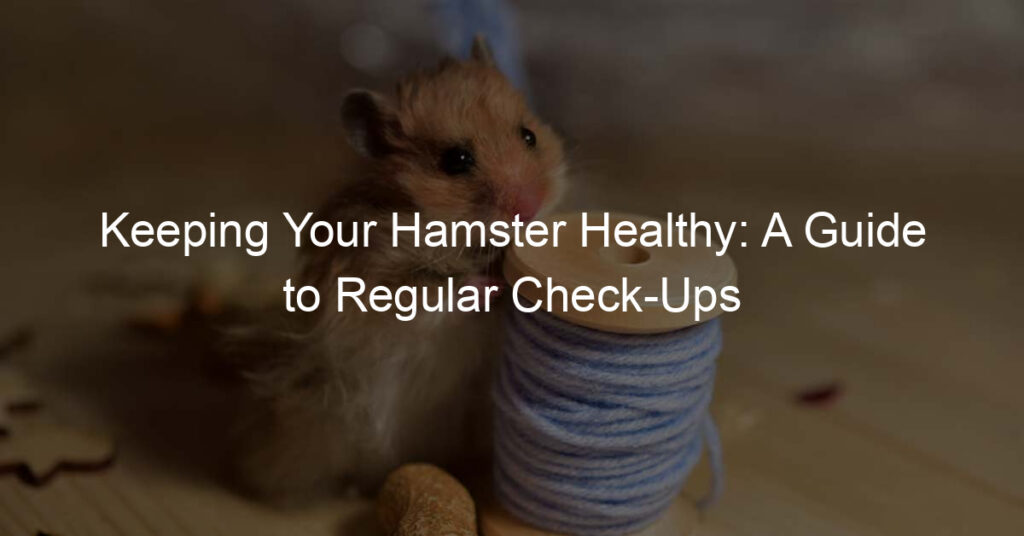
Introduction to Hamster Health
Hamsters are small, adorable pets that bring joy to many households. However, like all pets, they require proper care and attention to ensure they live a healthy and happy life. This includes monitoring their health regularly and being aware of common health issues they may face. Let’s delve into these aspects in more detail.
- Importance of Monitoring Pet Health
- Common Hamster Health Issues
Monitoring your hamster’s health is crucial. It helps you to detect any signs of illness early, which can make a significant difference in your pet’s well-being. Regular health checks can prevent minor issues from becoming major problems. For instance, weight loss might indicate a dietary issue that can be easily corrected if caught early. On the other hand, ignoring such signs could lead to severe health problems.
Hamsters, like other pets, are susceptible to various health issues. Some of the most common ones include respiratory infections, diarrhea, and skin problems. Respiratory infections can be caused by cold drafts, while diarrhea is often a result of a poor diet. Skin problems can occur due to mites or allergies. Being aware of these common issues can help you take preventive measures and seek timely treatment if your hamster falls ill.
Understanding your hamster’s health and well-being is the first step towards providing them with a safe and comfortable environment. In the following sections, we will explore more about hamster well-being, regular pet check-ups, hamster care at home, and other essential pet health tips.
Understanding Hamster Well-being
Hamsters, like all pets, require careful attention to their physical well-being. This involves observing their behavior, appearance, and activities closely. Let’s delve into the key aspects of a hamster’s physical health.
Physical Well-being
Physical well-being is a crucial aspect of your hamster’s overall health. It involves their diet, exercise, and regular check-ups. Here are some important points to consider:
- Signs of a healthy hamster
- Physical changes to watch out for
A healthy hamster is active, alert, and has a good appetite. Their eyes should be clear and bright, and their fur should be clean and well-groomed. They should have a steady weight, and their teeth should be well-aligned. A healthy hamster also has a clean and dry nose, and their droppings should be firm and dark.
Changes in your hamster’s physical appearance or behavior can be a sign of health issues. These changes may include weight loss or gain, dull or patchy fur, runny nose or eyes, changes in their droppings, or decreased activity levels. If you notice any of these signs, it’s important to consult a vet immediately.
Remember, your hamster’s physical well-being is a key aspect of their overall health. Regular check-ups and close observation can help ensure your pet stays happy and healthy.
Mental Well-being
Just like humans, hamsters also have mental health needs. Understanding their behavior and recognizing signs of stress can help ensure their mental well-being.
- Understanding Hamster Behavior
Hamsters are nocturnal creatures, meaning they are most active during the night. They love to explore, play, and exercise, and they need these activities for their mental stimulation. A bored hamster may exhibit signs of stress or depression, such as over-grooming or loss of appetite.
Hamsters also have a strong instinct to burrow and hoard food. Providing them with enough bedding for burrowing and a place to store their food can help satisfy these instincts and contribute to their mental well-being.
- Signs of Stress in Hamsters
Stress in hamsters can manifest in various ways. Here are some signs to watch out for:
| Signs of Stress | Description |
|---|---|
| Over-grooming | Hamsters may groom themselves excessively to the point of causing bald spots or sores. |
| Loss of Appetite | Stressed hamsters may eat less or not at all. |
| Aggression | They may become more aggressive, biting or scratching when handled. |
| Changes in Activity Levels | They may become less active or show signs of lethargy. |
If you notice any of these signs in your hamster, it’s important to address the cause of the stress. This could involve making changes to their environment, providing more mental stimulation, or seeking advice from a vet.
Regular Pet Check-ups
When it comes to your hamster’s health, regular check-ups play a pivotal role. Let’s delve into why these check-ups are so important.
Why Regular Check-ups are Important
There are two main reasons why regular pet check-ups are crucial:
- Preventive Care: Regular check-ups are an essential part of preventive care. These visits allow your vet to keep track of your hamster’s health and ensure they are up-to-date on vaccinations and treatments. Preventive care can help keep your pet healthy and potentially avoid serious health issues down the line.
- Early Detection of Health Issues: Regular check-ups can help detect health issues at an early stage. Early detection can make a significant difference in the outcome of many health conditions. It can mean the difference between a minor, manageable condition and a serious, potentially life-threatening illness.
Regular check-ups are not just about finding and treating problems. They are also about maintaining your hamster’s overall well-being. By scheduling regular check-ups, you are taking a proactive step towards ensuring your pet’s health and happiness.
What to Expect During a Check-up
When you take your hamster for a regular check-up, there are two main things that the vet will focus on. These are the physical examination and the behavioral assessment. Let’s delve into each of these to understand what they entail.
- Physical Examination
The physical examination is the first part of the check-up. This is when the vet will look at your hamster’s body to make sure everything is okay. They will check the hamster’s weight and size, as these can be indicators of health. A sudden change in weight could mean that your hamster is not eating properly or could be sick.
The vet will also look at your hamster’s fur and skin. Healthy fur should be clean and smooth, not matted or patchy. The skin should be free of sores or unusual spots. The vet will also check the eyes, ears, and teeth of your hamster. These should be clean and free of any discharge or unusual smells.
Lastly, the vet will listen to your hamster’s heart and lungs. This is to make sure that your hamster’s heart is beating normally and that their breathing is regular. Any irregularities could be a sign of a health problem.
- Behavioral Assessment
The second part of the check-up is the behavioral assessment. This is when the vet watches your hamster to see how they behave. The vet will look for signs of stress or discomfort, such as excessive grooming, hiding, or aggressive behavior. These could be signs that your hamster is not feeling well.
The vet will also observe how your hamster moves. Hamsters should be active and agile, not lethargic or unsteady. If your hamster is having trouble moving or seems to be in pain, this could be a sign of a health problem.
By understanding what to expect during a check-up, you can better prepare your hamster for their visit to the vet. Remember, regular check-ups are an important part of keeping your hamster healthy and happy.
Hamster Care at Home
Providing the right care for your hamster at home is crucial to its health and happiness. This involves daily care routines such as feeding and cleaning. Let’s delve into these aspects.
Daily Care
Daily care for your hamster involves two main tasks: feeding and cleaning. Both of these tasks are essential for maintaining your hamster’s health and well-being.
- Feeding
- Cleaning
Feeding your hamster a balanced diet is crucial for its health. Hamsters are omnivores, which means they eat both plants and meat. A typical hamster diet should include fresh fruits, vegetables, grains, and a small amount of protein. It’s also important to provide clean, fresh water for your hamster daily. Overfeeding should be avoided as it can lead to obesity and other health issues.
Keeping your hamster’s living environment clean is just as important as providing a balanced diet. Hamsters are clean animals and a dirty cage can lead to stress and illness. It’s recommended to clean the cage at least once a week. This includes changing the bedding, cleaning the food and water dishes, and removing any waste or spoiled food. A clean environment will keep your hamster healthy and happy.
In conclusion, daily care for your hamster involves proper feeding and regular cleaning. By following these simple steps, you can ensure your hamster lives a healthy and fulfilling life.
Exercise and Play
Exercise and play are essential aspects of a hamster’s life. They contribute significantly to the overall health and happiness of your pet. Let’s delve into why exercise is important for hamsters and what safe toys and activities you can provide them.
- Importance of Exercise for Hamsters
Hamsters are naturally active creatures. In the wild, they travel long distances in search of food. This instinct doesn’t disappear in a domestic setting. Exercise helps hamsters maintain a healthy weight and prevents obesity, a common health issue in pet hamsters. It also helps them to avoid boredom and the behavioral problems that can come with it, such as chewing on cage bars or over-grooming.
Regular exercise can also improve a hamster’s lifespan. A study conducted by the University of Liverpool found that hamsters who had access to an exercise wheel lived up to 1.3 years longer than those who didn’t.
- Safe Toys and Activities for Hamsters
Providing safe toys and activities for your hamster is a great way to ensure they get enough exercise. Here are a few options:
- Exercise Wheels: These are a must-have for any hamster cage. They allow your hamster to run as much as they want, even when you’re not around. Make sure the wheel is solid, without any gaps where your hamster could get their feet caught.
- Hamster Balls: These are a great way for your hamster to explore outside their cage. However, they should only be used under supervision and for short periods, as they can be tiring and stressful for your pet.
- Tunnels and Tubes: Hamsters love to burrow, and tunnels can mimic this natural behavior. They can also be a fun addition to your hamster’s cage or playpen.
- Chew Toys: Chewing is a natural behavior for hamsters and helps keep their teeth healthy. Providing chew toys can also help prevent boredom.
Remember, it’s important to monitor your hamster while they’re playing to ensure they’re safe and not ingesting any harmful materials.
| Toy | Benefits | Precautions |
|---|---|---|
| Exercise Wheel | Allows for unlimited running | Ensure it’s solid with no gaps |
| Hamster Ball | Allows exploration outside the cage | Use under supervision and for short periods |
| Tunnels and Tubes | Mimics natural burrowing behavior | Ensure they’re safe and non-toxic |
| Chew Toys | Helps keep teeth healthy and prevents boredom | Ensure they’re safe and non-toxic |
Pet Health Tips
One of the key aspects of maintaining your hamster’s health is through proper feeding. A balanced diet is crucial to ensure your hamster remains active and healthy.
Feeding Your Hamster
Feeding your hamster the right food is essential for their well-being. Let’s delve into the specifics of a healthy diet for hamsters and which foods to avoid.
- Healthy diet for hamsters
- Food to avoid
Hamsters thrive on a diet that includes a variety of foods. They need a balanced mix of fruits, vegetables, grains, and proteins. Fresh fruits and vegetables like apples, carrots, and broccoli can be given in moderation. Hamsters also enjoy grains such as oats and barley. Protein sources can include boiled eggs and cooked chicken. Always ensure that the food is fresh and clean.
While hamsters can eat a variety of foods, there are certain items that should be avoided. These include chocolate, caffeine, onions, garlic, raw potatoes, and citrus fruits. These foods can be harmful to your hamster’s health. Also, avoid feeding your hamster any food that is spoiled or moldy as it can lead to serious health issues.
Remember, a healthy diet is the foundation of your hamster’s overall health. By providing a balanced diet and avoiding harmful foods, you can ensure your hamster lives a long, healthy life.
Handling Your Hamster
Handling your hamster correctly is crucial for their health and well-being. It helps to build trust between you and your pet, and also allows you to check for any signs of illness or injury. Here are some tips on how to handle your hamster properly and signs to look out for that may indicate distress.
- Proper handling techniques
- Signs of distress during handling
When handling your hamster, it’s important to be gentle and calm. Start by washing your hands to remove any scents that might scare your hamster. Then, scoop your hamster up from the bottom, never grab them from the top. This can make them feel like they are being attacked by a predator. Hold your hamster close to your body or over a soft surface to prevent injury if they fall. Remember to handle your hamster regularly to help them get used to human contact.
It’s important to be aware of signs that your hamster is feeling distressed or uncomfortable. These can include squeaking, biting, trying to escape, or freezing in place. If your hamster shows any of these signs, it’s best to put them back in their cage and give them some space. Over time, with patience and gentle handling, your hamster should become more comfortable with being held.
Remember, every hamster is unique and may react differently to handling. It’s important to be patient and adjust your handling techniques to suit your individual hamster’s needs. With time and patience, you can build a strong bond with your hamster and ensure their health and happiness.
Hamster Health Guide: Case Studies
Let’s delve into some real-life examples that highlight the importance of maintaining hamster health. These case studies will provide a clearer understanding of the impact of early detection of health issues and the role of diet in hamster health.
-
Case Study 1: Early Detection of Health Issues
Consider the case of a hamster named Fluffy. Fluffy’s owner noticed that he was less active than usual and was not eating his food properly. Instead of dismissing it as a temporary phase, the owner decided to consult a vet.
The vet conducted a thorough examination and discovered that Fluffy was in the early stages of a respiratory infection. Because of the early detection, Fluffy was able to receive immediate treatment. This not only saved Fluffy from severe discomfort but also prevented the infection from escalating into a life-threatening condition.
This case study underscores the importance of observing your hamster’s behavior and seeking professional help at the first sign of abnormality. Early detection and treatment can be the key to your hamster’s long and healthy life.
-
Case Study 2: Impact of Diet on Hamster Health
Now, let’s look at the case of a hamster named Daisy. Daisy’s owner fed her a diet primarily consisting of hamster pellets, with occasional treats of fruits and vegetables. Over time, Daisy started gaining weight and became lethargic.
Upon consulting a vet, the owner learned that while hamster pellets are a good source of nutrition, they should not be the only food in a hamster’s diet. The vet recommended a balanced diet that included a variety of fruits, vegetables, and grains, in addition to hamster pellets.
After a few weeks of following the vet’s dietary advice, Daisy’s weight returned to normal, and she became more active. This case study illustrates the significant impact diet can have on a hamster’s health and well-being.
These case studies emphasize the importance of early detection of health issues and a balanced diet in maintaining hamster health. As a responsible pet owner, it is essential to pay attention to these aspects to ensure your hamster’s long and healthy life.
Maintaining Hamster Health: Key Takeaways
As we draw to a close on our comprehensive guide to hamster health, it’s important to summarize the key points. These takeaways will provide a quick reference guide for maintaining your hamster’s health and well-being.
- Importance of regular check-ups
- Signs of health issues in hamsters
- Best practices for hamster care at home
Regular veterinary check-ups are crucial for your hamster’s health. These check-ups help to identify any potential health issues early, allowing for timely treatment. According to a study, hamsters that receive regular check-ups have a higher chance of living a longer, healthier life.
Being observant of your hamster’s behavior and physical condition is key to identifying health issues. Some common signs of health problems include changes in eating or drinking habits, lethargy, weight loss, and abnormal droppings. If you notice any of these signs, it’s important to seek veterinary advice immediately.
Proper hamster care at home is essential for their well-being. This includes providing a clean, spacious habitat, a balanced diet, and plenty of exercise. Additionally, handling your hamster gently and regularly can help build trust and reduce stress, contributing to their overall health.
| Key Takeaways | Details |
|---|---|
| Regular Check-ups | Helps in early detection of potential health issues. |
| Signs of Health Issues | Changes in behavior, eating, drinking habits, and physical condition. |
| Hamster Care at Home | Provide clean habitat, balanced diet, and regular exercise. |
In conclusion, maintaining your hamster’s health requires a combination of regular veterinary care, keen observation of their behavior and physical condition, and proper care at home. By following these key takeaways, you can ensure that your hamster lives a long, happy, and healthy life.








